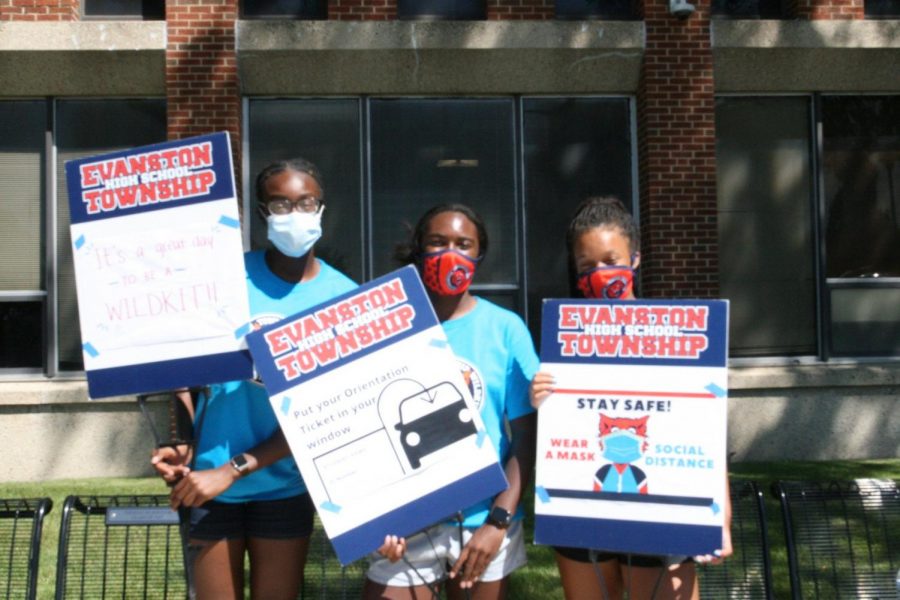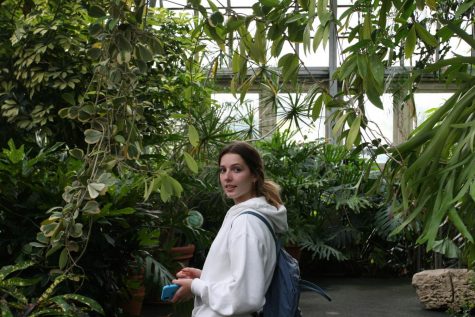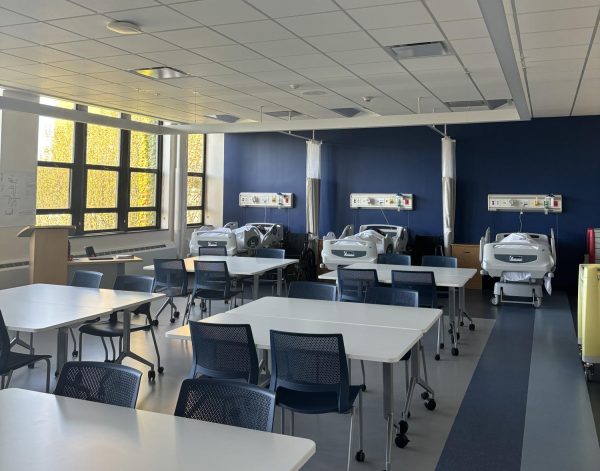ETHS reopens in a vastly different world
ETHS welcomes freshmen during a materials pickup on Aug. 10.
August 17, 2020
The 2020-2021 school year is beginning as scheduled on August 17; however, ETHS will be using a brand-new model of remote learning developed in response to the COVID-19 pandemic known as enhanced e-learning.
“Enhanced e-learning [means that] we’re not going to be doing the same thing we were doing in the spring,” Assistant Superintendent and Principal Marcus Campbell said in an interview with The Evanstonian. “There were no synchronous learning opportunities in the spring, so we’re going to make sure we’re doing that. [In the spring] the state really restricted us from having an impact with grades [because they weren’t allowed to decrease], so that’s going to be different.”
A task force of about 100 people worked over the summer to design this model, which will feature elements of both synchronous learning—with students attending class sessions on Zoom or Google Meet and working collaboratively with classmates—and asynchronous learning—in which students complete assignments on their own time by a specific due date. Live learning sessions are now mandatory, and daily attendance is taken in an attempt to maximize student engagement. In addition, there is a return to the A-F grading scale.
The District 202 School Board has released no official time frame as to when ETHS might transition from this fully remote plan into a hybrid in-person/remote plan, stating in the reopening plan that the school will do so “if conditions permit.” However, at the E-Town Live held on Aug. 7, Superintendent Eric Witherspoon said, “I think we all need to really get a mindset, that [e-learning] could easily be the entire fall semester,” citing multiple statistics of the virus surging around the country.
The new e-learning format will be a major transition for all ETHS students, but it will affect each student in unique ways. Freshmen are beginning their high school journey in a setting that is entirely new to them and having to meet many new faces from behind a computer screen.
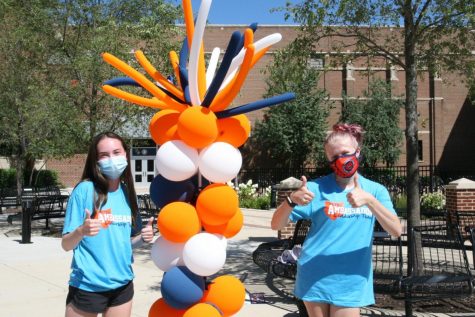
Isabel Rosenberg, an incoming freshman, said she is “sad to have school online, but she understands “why it’s necessary.”
Rosenberg has been participating in the ETHS summer running program, which has allowed her to build relationships with other students despite not being in the building with them come fall.
For seniors, who have already been through numerous first days of school, starting online will be a stark change to what they are used to.
“I’m disappointed about not starting school live, especially as a senior, but I also know going back would not feel like the same school I love,” senior Nikki Levee said. Levee is most disappointed about the postponing of YAMO—an ETHS theater production consisting of sketch comedy, singing and dance—and the lack of live interactions with teachers and friends in the building.
“I’m hoping since we are more experienced with e-learning and this pandemic that the next few months can be smoother and more enjoyable for the students and staff,” Levee said.
Senior Naiyah Bryant also foresees difficulty in adjusting to the remote school environment while recognizing its necessity.
“I think it’s the safest option for our school and community,” Bryant said. “The switch to remote learning will definitely push me and other students to be creative with extracurriculars which will be a challenge.”
In order to give ETHS staff the best shot at adapting to this drastically different teaching model, the EdTech Team hosted an E-Learning Academy over the summer with topics including classroom climate, planning, content delivery, discussion and feedback, assessment and refining technology skills. Google Classroom will now serve as the mandatory learning management system for all teachers.
“Our teachers have been in training this summer on various aspects of how to really teach remotely with a number of programs and a number of apps,” Campbell said. “It’s a bright spot, and it’s been a bright spot for us, during such a dark time.”
Director of Instructional Technology David Chan helped create the academy with the goal of maximizing the effectiveness of enhanced e-learning.
“This lets our teachers really reflect on how they can best deliver their instruction in an e-learning format come this fall,” Chan said.
In addition to further training, teachers in all subjects have used the summer to prepare for remote instruction. Freshman and AP Biology teacher Teresa Granito shared that she will be relying on College Board materials, videos, Khan Academy, interactive virtual labs and more to continue learning in her remote biology classes.
“We’ll have Powerpoints, we will have study guides, review guides, everything. All stuff that we did for kids before, [this year’s students] will also have,” Granito said. “I could have [lectures], I could put [students] in breakout rooms working together [which will also] get them to know the other kids.”
In addition to creating a new model for education, staff have also worked on highlighting the social-emotional needs of students during remote learning. A team including history teacher Aaron Becker, fine arts teacher Karla Clark, math teacher Raquel Lopez, physics teacher Mark Vondracek and Associate Principal for Student Services Taya Kinzie worked to help all ETHS teachers understand what social-emotional learning (SEL) is and how to incorporate it in their remote lessons.
“By having teachers understand what SEL is and the benefits that can bring students and, quite frankly, society, we hope to be able to include social-emotional learning components even more effectively and purposefully to make a student’s experience in school even better,” Vondracek said.
In the remote environment where in-person human interaction is scarce, this team hopes social-emotional learning will help everyone adjust while still being part of a classroom community.
“We have to build the community in an environment where we also know communication with each other is limited,” Vondracek said. “We all must take the mindset that we’re in it together, we want to make the most of the situation until we can begin to go back to school in a hybrid model.”
Students with Individualized Education Programs (IEPs) will also be fully accounted for in the new enhanced e-learning plan.
“Every IEP student will have an Individual Remote Plan created by their case manager as an addendum to their current IEP,” Director of Special Education Diona Lewis said. “The creation of this document will be in partnership with the family to specifically address and align their IEP to student needs in a remote or hybrid environment.” Similar accommodations will be made for students with 504 plans.
According to Lewis, “teachers will focus on the importance of relationship development and feedback as part of their instruction.” This way, teachers can create and maintain a line of communication that will be crucial to the success of the students and their families.
Beyond academics and wellbeing, a student activity task force met over the summer to discuss how potential reopening plans would impact activities during the school year.
A newly created fall sports season began on August 10, including only the “lower risk” sports which were deemed by the Illinois High School Association (IHSA) to be boys and girls cross country, boys and girls golf, girls swimming and girls tennis.” On August 11, ETHS released the safety guidelines for extracurricular activities. No events will be held inside the building. At outdoor, in-person events guidelines include self-screening and temperature checks conducted upon arrival, mask and social distance requirements and 25 person activity pods.
“We had representatives from athletics, fine arts, student activities, incoming students, and community service discuss next steps, process and procedures,” task force member and Community Service Coordinator Diana Balitaan said.
There have also been efforts to welcome incoming freshmen to ETHS and inform them of student activity opportunities with the new Wildkit Welcome website, created by new student transition coordinator Alicia Hart. Incoming freshmen are able to access information sessions of various extracurriculars, read advice from current students and access resources to learn more about ETHS. Class of 2024 signs were also placed in the lawn of every incoming freshman to welcome them to ETHS.
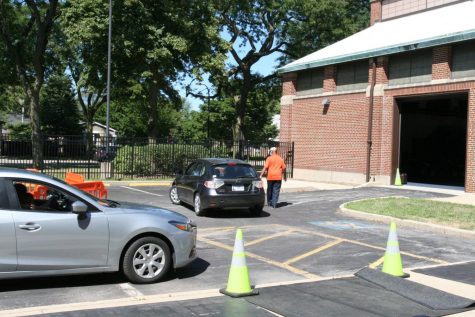
“We really want them to see and understand that they now are part of the Wildkit family even though we haven’t seen them yet,” Campbell said.
At the end of the day, it is the students and staff of ETHS who will have to persevere through these trying times and make the most out of the new e-learning format that was so thoughtfully prepared by administrators and faculty.


